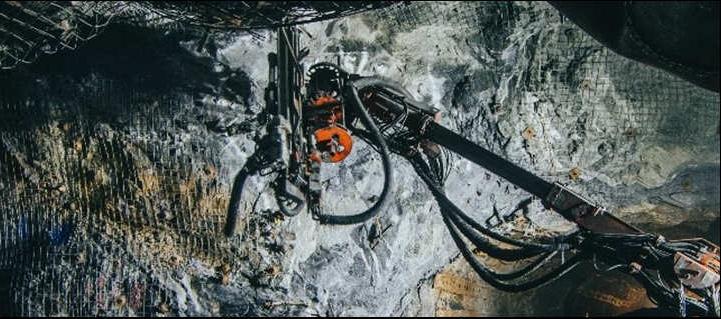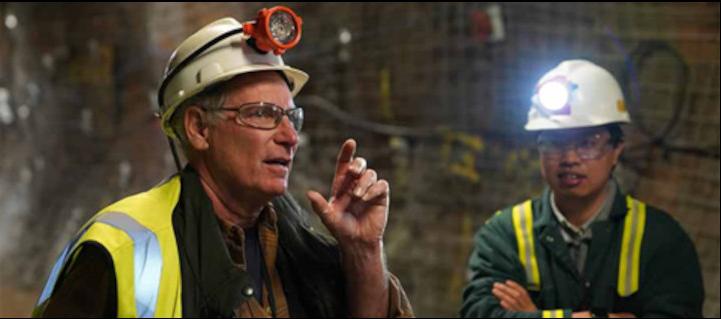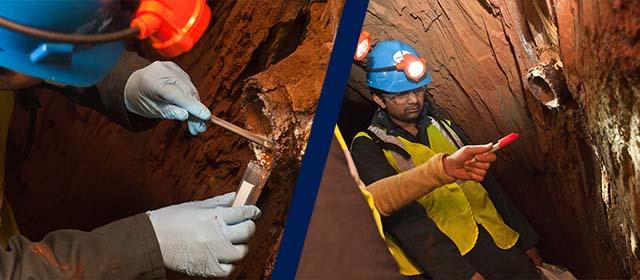South Dakota Mines faculty, students, and alumni across campus are involved in every aspect of the Sanford
Underground Research Facility (SURF) located in the Black Hills town of Lead, about an hour from campus.Â
 A rainbow near the top of the Yates Shaft at SURF. Photo credit SURF by Jarred Burleson
A rainbow near the top of the Yates Shaft at SURF. Photo credit SURF by Jarred Burleson
SURF is the nation’s underground lab. The deepest parts of the facility are almost one mile below the surface and SURF is also home to a wide array of world-class research.
Here are a few examples of many projects Mines students, alumni, and faculty are involved in.Â
The
LUX-ZEPLIN (LZ) Experiment – Leading the Hunt for Dark Matter
Mines researchers play a vital role in running and maintaining the world’s most sensitive dark matter detector, the LUX-ZEPLIN (LZ) experiment.Â
Read more at Students and Faculty Assist in Successful Startup of LUX-ZEPLIN.
 Mines student Jack Genovesi runs cables above a data acquisition rack during upgrades on the LZ experiment at the 4850 level of SURF.
Mines student Jack Genovesi runs cables above a data acquisition rack during upgrades on the LZ experiment at the 4850 level of SURF.
The Deep
Underground Neutrino Experiment – Setting the Stage for Major BreakthroughsÂ
Mines is integral to the massive Deep Underground Neutrino Experiment now under construction at SURF. DUNE includes a beam of neutrinos generated at the particle accelerator at Fermilab near Chicago that will be shot through the curvature of the earth
to massive multi-story building sized targets of liquid argon located in a huge cavern being excavated 4850 feet below ground at SURF.Â
Read more at DUNE.
 The excavation for DUNE, underway at the lab. Photo by: SURF
The excavation for DUNE, underway at the lab. Photo by: SURF
CASPAR - Discovering
the Inside of Collapsing Stars with a Particle Accelerator
South Dakota Mines leads the Compact Accelerator System for Performing Astrophysical Research (CASPAR) collaboration. CASPAR is a low-energy accelerator that allows researchers to study processes that take place inside collapsing stars.
Read more at
Strieder Leads Sanford Lab CASPAR Team in Unlocking the Secrets of the Universe
and CASPAR.Â
 Mines student, Thomas Kadlecek explains some of his work at CASPAR.
Mines student, Thomas Kadlecek explains some of his work at CASPAR.
KisMET and EGS Collab – Researching the Cutting Edge of Geoscience to Revolutionize Clean Energy
Research led by Mines faculty and students is exploring the possibility of enhancing geothermal energy production deep underground. The final outcome of this collaboration could mean a huge new source of clean geothermal energy to power the world.
Read more at Mines Researchers Explore Hydraulic Fracturing to Expand Geothermal Energy and CASPAR.
 Mines faculty members Dr. Bill Roggenthen (emeritus) and Dr. Liangping Li are among the many contributors to the EGS Collab at SURF.
Mines faculty members Dr. Bill Roggenthen (emeritus) and Dr. Liangping Li are among the many contributors to the EGS Collab at SURF.
The MAJORANA Demonstrator - Probing the imbalance of matter and
antimatter in the universeÂ
Mines instructor and research scientist in the Karen M. Swindler Department of Chemical and Biological Engineering, Cabot-Ann Christofferson, is the liaison for the MAJORANA Project for Oak Ridge National Lab. The MAJORANA Demonstrator uses natural and
enriched germanium crystals to search for neutrino-less double-beta decay. A discovery could determine whether the neutrino is its own antiparticles.
 Photos by Matthew Kapust, at SURF of Cabot-Ann Christofferson on her way to work and showing researchers working on equipment inside the MAJORANA Demonstrator.
Photos by Matthew Kapust, at SURF of Cabot-Ann Christofferson on her way to work and showing researchers working on equipment inside the MAJORANA Demonstrator.
Advancing the frontiers of micro-biology: Researchers Evaluate SURF Extremophiles
The Sanford Lab is a treasure trove of microbes that live deep underground in conditions with no light and limited resources. These forms of microbial life are called extremophiles and they are at the center of a range of groundbreaking biology and biological
engineering efforts, from the creation of new biofuels to the invention of new medicines.
Read more at As Good as Gold and South Dakota Mines Researchers Hope to Use Sanford Lab Extremophiles to Create Low-Cost Renewable and Biodegradable Polymers.
 Mines researchers collect extremophiles inside SURF. Photo credit: SURF
Mines researchers collect extremophiles inside SURF. Photo credit: SURF
Undergraduate
research: Peering inside the Earth with a Raspberry Shake to open new doors in Seismology
Mines students and faculty are continuously engaged in research projects at SURF. In one recent study Elise Staat, a senior geology student at South Dakota Mines, and her advisor, Kevin Ward, Ph.D., assistant professor of geology and geological engineering
at Mines, may have found a relatively inexpensive way to measure the thickness of the Earth’s crust using seismic waves. Mines Student Calculates Depth of the Earth's Crust with "Raspberry Shake" Data at Underground Lab. This study is of one of many that engages Mines undergrads and graduate students at SURF.Â
 Elise Staat holds a Raspberry Shake seismometer she built as part of her undergraduate research at SURF.
Elise Staat holds a Raspberry Shake seismometer she built as part of her undergraduate research at SURF.
Leading the Way in Infrastructure Engineering and Maintenance
SURF is huge. There are 370 miles of shafts, drifts, and ramps in the former gold mine including about 12 miles maintained by the lab for science activities today. The large infrastructure at SURF requires engineers from many backgrounds. Many Mines alumni
are now employed at SURF as engineers and job opportunities at the facility are expected to grow in the coming years.
 Photo Courtesy SURF, Kiewit-Alberici Joint Venture.
Photo Courtesy SURF, Kiewit-Alberici Joint Venture.
